Projects
IIT Madras Student Satellite Project (IITMSAT)
Duration: March 2011- August 2014
What is IITMSAT?
IITMSAT is a student satellite initiative to design and build a Nano satellite which will study the features of plasma in the upper ionosphere to characterize its relation with earth-based phenomena like seismic activity. This unique study is made through a Space Based Proton- Electron Energy Detector (SPEED) payload on-board the satellite capable of measuring the energy spectrum of plasma. The satellite is currently in its engineering phase and is expected to launch in 2015.
I have been involved in the development of SPEED for nearly 30 months now. A summary of the areas I have worked on are:
-
Detector systems engineering/Design of mass and energy budgets for SPEED
-
Fabrication of detector elements
-
Conducting experiments to optimize sensor specifications
-
Preliminary design of the detector’s analog electronics
-
Structural and Thermal design of SPEED
As part of this project, I have participated / presented in many reviews consisting of faculty and ISRO committees. I was also involved in several group visits, including the Tata Institute of Fundamental Research (Mumbai) and Indira Gandhi Center for Atomic Research (IGCAR).
My work has culminated in many technical documents on a variety of aspects detailed above. A collection of some of these documents can be viewed here.
Over the course of the last 1 year, I have been leading the design of the support structure of SPEED, heading a team of 5 students. An abstract of this project is as follows:
Abstract:
The basic objective of this project was to build an aluminum support structure to support the SPEED payload, so that it can be successfully integrated into the Nano satellite body. The structure needs to meet the mass and space constraints set by the nanosatellite and the stringent launch conditions set by the Polar Satellite Launch Vehicle (PSLV), the rocket used by the Indian Space Research Organization (ISRO). The launch conditions are specified as a critical stress, shock and random vibration tolerance limits.
The solution was arrived at by iterative design and structural analysis, using the combination of Solidworks and Abaqus, a Finite Element Software. These components were manufactured by 3-D printing and CNC machining. An experimental validation of both the structural and thermal aspects of the design is expected to take place later this year.

3-D rendered view of IITMSAT, with the SPEED payload instrument on top and the inverted F- antenna surrounding it.
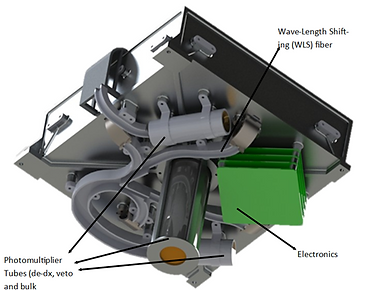
A 3-D view of the SPEED payload housed in a specially designed aluminium casing, with routing assemblies for wavelength -shifting (WLS) fibers, Photomultiplier tubes and the electronics PCB's.

Top(left): First views of the manufactured casing.

Top(right): A sequence of images showing the first 6 modes of the payload casing during a modal analysis test on Abaqus, a finite element software.
Devlopment of a Prototype of a Charged Particle Detector
Duration: 3 weeks ( July 2012)
Guide: Dr. Kajari Mazumdar
I and a teammate had visited the High Energy Physics Laboratory at Tata Institute of Fundamental Research, Bombay during summer 2012 to develop a prototype of the detector on-board IITMSAT.
Abstract
The basic objectives of this research project were to gain an experimental understanding of a charged particle energy and count measurement system and build a thin plastic scinitllator, coupled with wavelength shifting fibers. The plastic scintillator was etched using a CNC machine to accommodate a pattern of wavelength shifting fibers such that these fibers were not bent beyond their critical radius of curvature. Once manufactured and assembled, we calibrated the scintillator using a muon source, a photomultiplier tube (PMT) and a multichannel analyzer. We also performed several experiments to understand the working of a PMT.
The documentation for this project can be viewed here.

The thin plastic scintillator with Wavelength shfiting fibers on its surface, designed to transport light to Photomultiplier tubes.
Devlopment of a Serial Communication Interface for Satellite Sun Sensor and Magnetometer Calibration
Duration: 10 weeks ( May-July 2013)
Guides: Dr. Ing Tino Schmiel, Dr. Andreas Weber
I spent 10 weeks in the Institute for Space Systems at Technische Universitat Dresden, Germany as part of the DAAD ( German Academic Exchange Service) scholarship program. I was involved in the initial development phase of the SOMP-II satellite, working on the Attitude Determination and Control subsytem.
Abstract
The main objective of this project was to mimic the orbital motion of a satellite using a dual-axis turntable, current carrying coils and an artificial lamp, which together could create the magnetic field and illumination that the satellite would have experienced in orbit. I was involved in developing the control software which could send the rotation commands to the turntables and the microcontroller which varied currents in the magnetic field coils. The software can also receive sun angle data from the satellite placed on the 2-axis calibration testbed and magnetometer data via the microcontroller, and this can be used to verify the functioning of the sunsensors and the magnetometer. The control software was coded into a GUI so that all the user had to do was to set his orbital parameters and a complete simulation of the orbit can be achieved .
The documentation for this project can be found here.
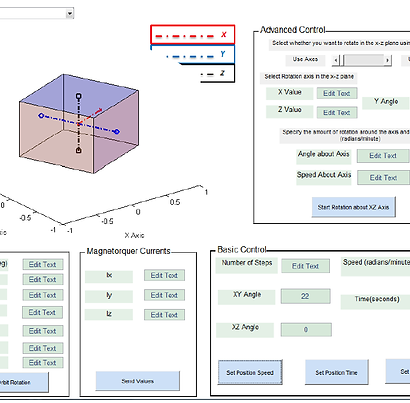
Screenshot of GUI developed for satellite ADCS calibration. The user can set orbit parameters and can view the live rotation of the satellite in the top left corner of the GUI (cube).
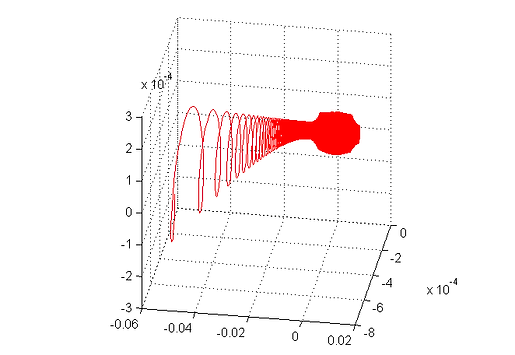
Optimization of the Thrust Produced by a Plasma Flow in a Magnetic Nozzle
Duration: September 2013 - April 2014
Guides: Dr. Harishankar Ramachandran, Dr. K Ramamurthi
Abstract
Magnetic Nozzles are used in high-power plasma thrusters to produce directed axial kinetic energy. Unlike conventional gas-dynamic nozzles, magnetic nozzles expand a very low density, low pressure, highly ionized plasma into vacuum by means of a strong, divergent magnetic field created by electromagnets.
In order to be viable for space propulsion, plasma needs to detach itself from the applied magnetic field downstream of the magnetic nozzle throat. In this project, first, a preliminary model of a magnetic nozzle is demonstrated using single particle simulations (Fig, right). A more realistic model of the magnetic nozzle is created using ATHENA, a Magnetohydrodynamic simulation code. Using a two-dimensional ideal MHD model, the performance and detachment of plasma from the magnetic nozzle for various applied field strengths is examined (Fig, bottom). This is used to derive conclusions on the regimes of operation in which the magnetic nozzle can be used as a space propulsion device.
A copy of the thesis for this project is available here.
A single particle simulation that demostrates the magnetic nozzle concept. The dense, red region shows the particle trap. Once the particle escpaes form the trap, its parallel velocity increases as it moves along the magnetic nozzle.
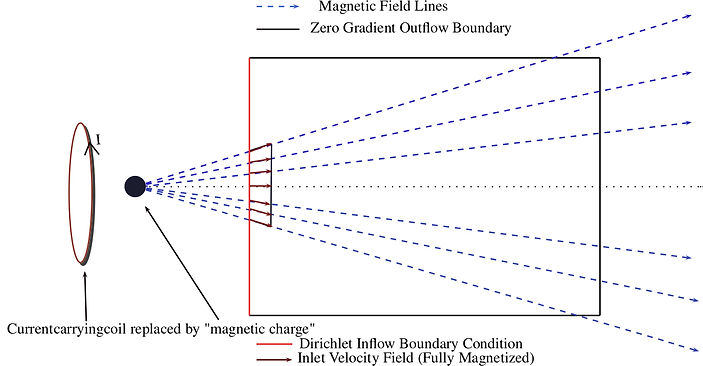
Ideal MHD simulation setup of the magnetic nozzle in ATHENA. The computational space is shown as a box, along with the different boundary conditions used at its edges. The magnetic field inside the computational space is created by a fictional "magnetic charge" which creates a cone-like magnetic field, as shown above. Plasma is injected at the left end (near the red line), and its flow is studied till the exit on the right (black line, opposite to red line).
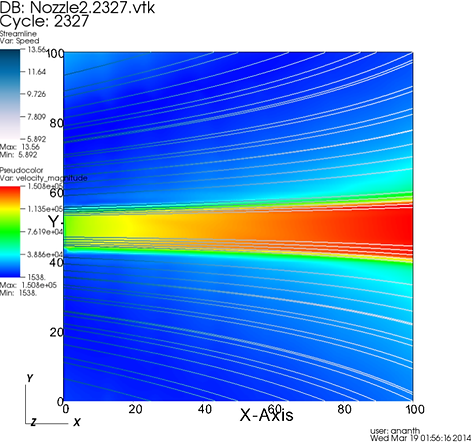
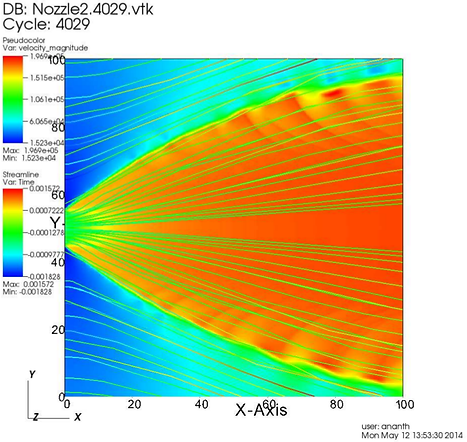
Converged, steady-state velocity profiles of plamsa in the magnetic nozzle from two cases. The white lines in the background represent the magnetic field lines. In the top, left panel, the flow of a β ≈ 10 plasma through the magnetic nozzle is shown. Note the plasma confinement & acceleration along the magnetic field lines. For the purpose of comparison, the top right panel shows a β ≫ 1 plamsa (which basically means that the magnetic field is non-existent, thus the behaviour should approach that of a gasdynamic nozzle).
Industrial Internship: Toolpath Optimization for an CNC Turret Punching Machine
Duration: Dec 2012-Jan 2013 ( 6 Weeks)
Company: Amadasoft India
Guide: Jackson Tholath, CTO, Amadasoft India
I spent 6 weeks at Amadasoft India, the software division of the Japanense firm Amada, which specializes in develping machines for sheet metal cutting.
Abstract
A CNC Punching machine consists of a turret with about 30 tools that can be used to punch specific patterns onto sheet metal. When moving from one punch location to another punch location, the table must move in the X and Y directions, whereas the turret must rotate such that the correct tool gets aligned with the sheet. The objective was to find the optimum sequence of punch co-ordinates to minimize the time wasted in moving from one punch location to another.
The approach was to develop a C++ algorithm modeled on a travelling salesman problem. In a departure from the traditional approach, we solved a clustered TSP taking into account all possible motions of the punch. The algorithm showed almost 30% improvement over Amada's current punching sequence algorithm.
A report of this project can be viewed here.


Top: A clustered representation of punch locations of a sheet metal.
Bottom: The optimal path obtained from these punch locations.
Study of Scattering using a 2-D Total Field/Scattered Field Perfectly Matched Layer
This was a classroom project, part of the graduate level course 'Computational Electromagnetics'.
Abstract
This report starts with the FDTD Method in Cylindrical Co-ordinates. We discuss the termination of the Cylindrical Grid by means of reflective, Bayliss-Turkel ABC, and a split field Perfectly Matched Layer Technique. The PML is validated by comparing the solution with a theoretical Monochromatic Cylindrical wave. This is followed by a description of a Total field/Scattered Field Perfectly Matched Layer implemented in Cartesian coordinates.
A report of this project can be viewed here.

In this simulation, we see a plane wave getting generated at the lower left end of the simulation space. An object of arbitrary geometry can be placed anywhere within the simulation space. When the plane wave strikes it, we can study the scattering pattern from the object.
Some other course Projects
I've done several other course projects in the 4 years at IIT-Madras.I am listing them here for completeness.
1) Complete Aerodynamic Design of an Axial Compressor and Turbine (2013): In this project, we were given a set of input parameters to design a fan and a compressor. A very detailed design was done in the course of 4 months, to the level where the design can actually go for manufacture.
2) Heat Transfer Issues in Solar Photovoltaic Systems (2013): In this term paper, I did a literature survey of the current state-of-the-art methods that provide maximum utilization fo incident light on a Solar Photovoltaic Panel.
3) Air Handling Systems for Large Power Plants (2013): In this project, I worked with a team of 5 people to come up with a basic design of the air handling components of a power plant.
4) Design of a Load Lifting Machine (2012): In this project, we had to design every part of a load lifting machine that could lift 10kgs. We hand-calculated all the basic design parameters and narrowed down to specific components that can be purchased from online product manuals.
5) Miniature Model of a Folding Wheelchair-Bed Mechanism (2012): We built a 1:50 scale model of a wheelchair that could convert into a bed. Dimensions and other parameters were decided after a force analysis done on paper.
© 2013 by Ananth Saran Yalamarthy